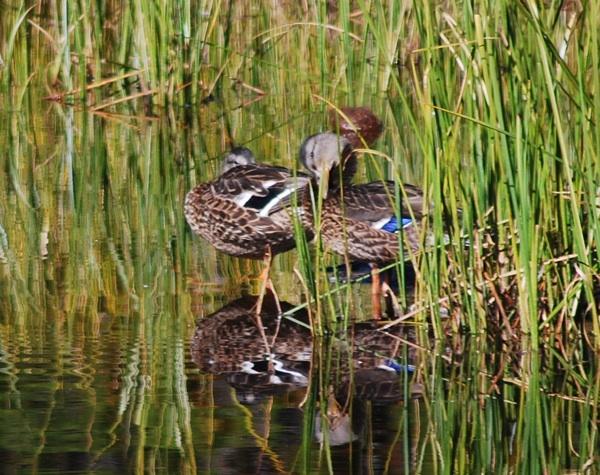What bird is this? Blue-winged teal? A green-winged teal of a different hue? If it is a blue-winged teal, what was it doing in Yosemite National Park, which claims the green-winged variety on its bird list but not Mr. Blue.
This shot was captured in late September near Cathedral Lakes.




Could be a juvenile mallard. Juvenile and non-mating vs. mating plumage colors are what often throw me with bird identifications.
rob
---
Executive Director,
Crater Lake Institute
Robert Mutch Photography
Juveniles? This looked like a nesting pair after the kids had flown!
My wife's thought -- and she just might have nailed it -- are that these are "Mexican" ducks. The clincher is the blue swatch on the speculum with the white borders.
http://www.npwrc.usgs.gov/resource/birds/waterfwl/mexican.htm
If so, is this new to Yosemite, as it doesn't appear on the park's bird list.
Ok here is my "two cents" on the subject. In trying to get my head around the subject of "ducks in the parks". I am curious about what appears to be longer than normal legs on this pair of mystery ducks. I looked at all of the possibilities and then took a look at the "Yosemite Bird List".
It appears that "Mr. Blue" can be found on the listing of ducks spoted "at least four times" on the final page of this report. Also that they do breed in the park.
If it is a "Mexican Duck" could it be considered an "illegal alien". ;o))
Semper Fi
Doc
Whichever or whatever it truly is. I call it beatiful and welcome to Yosemite.
I appreciate and enjoy all the splendor there. Ancient and living.
I think the first comment is about right. Non-breeding mallards (roughly mid-June through September) all look about the same, regardless of age or sex; all have the blue speculum with white borders, but males won't get their bright green heads until later this month. The yellowish bill on the front bird also says mallard; all the teal species have darker bills.
Doc if you look close at the "long legs" you see its just the reflection off the water. The midpoint of the legs in the photo are were they go into the surface of the water; or maybe its a two pairs of Siamese Ducks connected at the ankles. Heheheh. As to the status of there Nationality I think I see a visa, so they might be just legal tourist ducks.
Just busting your balls, not trying to out sharp shoot a Jar Head Doc but (I guess I am) that's what I do when I'm not overseas in the sand box working together with them. My Family is pretty well diversified with Army, Navy, and Marines. I being Army, love to mix it up with the Marines with good natured rivalry and ball busting, the Navy are guys are usually way to easy to mess with. -MIKE
Local 7.62
Pipe Hitters Union
HOOAH
this is a Mottled duck, they are often mistaken for mallards or black ducks. It is the least numerous duck in north america